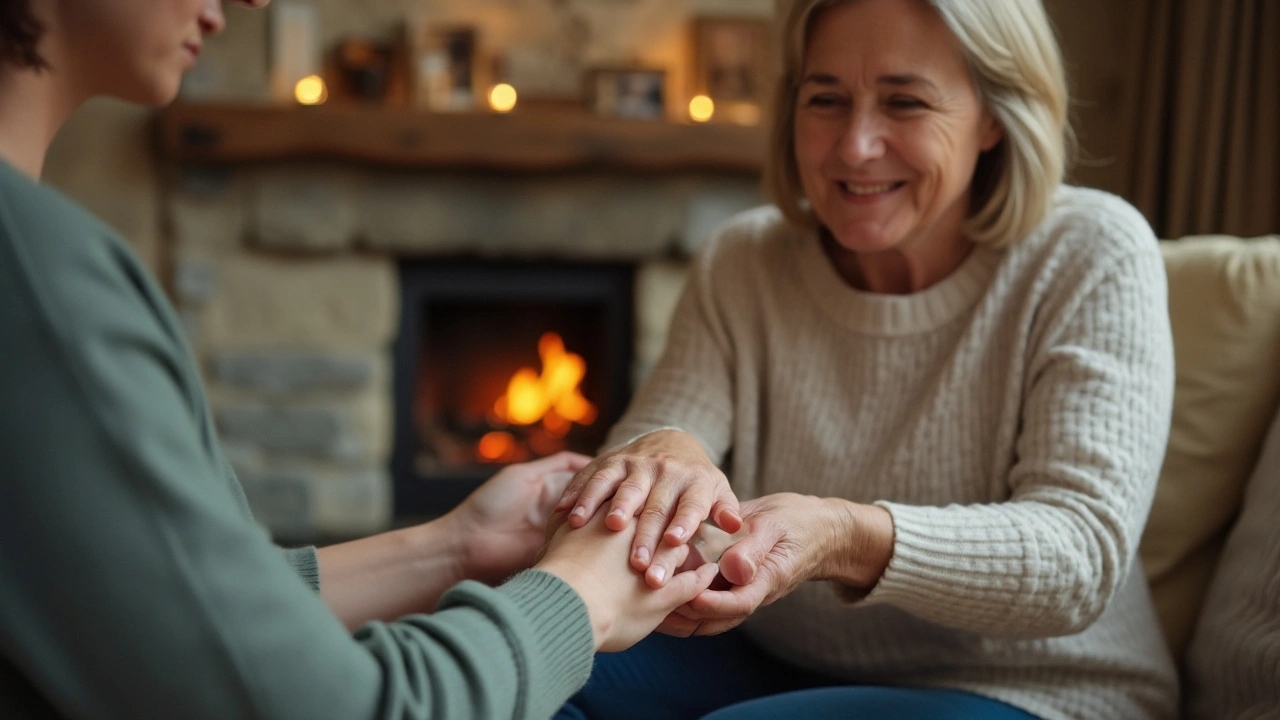Enhancing Comfort with Palliative Massage for Pain Relief

When faced with the challenges of serious illness, managing pain and ensuring comfort become top priorities. Palliative massage provides a calming, hands-on approach to relieve pain and anxiety for those in need of gentle care. This type of massage therapy is designed to address both physical discomfort and emotional stress, offering a multifaceted benefit to individuals receiving palliative care.
Through the power of compassionate touch, individuals experience relief and an improved sense of well-being. Techniques used in palliative massage are adaptable, addressing the unique conditions and preferences of each person. Whether it's through light strokes or targeted pressure, the aim is to promote relaxation and improve quality of life. As a complementary treatment in palliative care, massage therapy plays a significant role in holistic care plans, providing comfort while respecting the dignity and individual needs of the person.
- Understanding Palliative Massage
- Benefits of Massage in Pain Management
- Techniques and Approaches
- Integrating Massage into Care Plans
- Choosing a Qualified Practitioner
Understanding Palliative Massage
Palliative massage is a specialized form of therapy focused on providing solace and relief for individuals with life-limiting illnesses. This practice is deeply entrenched in the philosophy of palliative care, which aims to improve the quality of life for patients dealing with severe health conditions. Unlike traditional massage that might focus purely on relaxation or sports injuries, palliative massage offers tailored techniques that attend to the specific needs of those experiencing complex symptoms. The essence of this therapeutic approach lies in its gentle, considerate touch, which prioritizes comfort above all.
The roots of palliative massage are in its holistic perspective, combining physical and emotional support. Various techniques are implemented to accommodate a patient's changing condition. For instance, effleurage, a technique utilizing smooth, flowing strokes, is often employed to promote relaxation and enhance circulation. Despite these benefits, the approach remains flexible, always adapting to the physical limitations and preferences of the person receiving care. Renowned hospice care centers often incorporate this into treatment protocols, recognizing its profound impact. As one expert notes,
"Massage therapy in palliative care is not just about physical relief but also offers emotional comfort and a sense of connection,"further emphasizing the multi-layered advantages it provides.
Studies have highlighted several positive effects of incorporating palliative massage into patient care. Reports suggest that patients often experience lessened pain severity, reduced anxiety, and better sleep quality. A survey conducted across multiple hospice centers revealed that approximately 70% of patients receiving massage therapy reported significant improvement in their overall comfort levels. This evidence underscores the importance of this approach in managing the distress associated with advanced illnesses. These profound results reflect the delicate balance between human touch and compassionate care, making palliative massage a cornerstone in enhancing well-being amidst challenging circumstances.
Given its increasing recognition, understanding the elements that define a successful palliative massage can be enlightening for caregivers and practitioners. Key principles include personalization and sensitivity, ensuring each session considers the individual's pain points—both literally and figuratively. This involves clear communication to establish trust and to create an environment where patients feel heard and valued. Therapists undergo specialized training to equip them with the necessary skills to handle a diverse range of conditions, emphasizing empathy and discretion. The goal is not just temporary relief but a lasting improvement in the person's overall experience. Thus, integrating palliative massage into routine care emerges as a compassionate choice, showcasing its vital role in turning the tide of patient care towards a more humane approach.
Benefits of Massage in Pain Management
Pain management is a crucial aspect of palliative care, and palliative massage stands out as an effective strategy for providing relief and enhancing comfort. One of the primary benefits of this therapeutic form is its ability to reduce muscle tension and stiffness, which are common in patients coping with chronic pain. Through a series of gentle strokes and kneading techniques, massage therapy stimulates the release of endorphins, often referred to as the body's natural painkillers. This not only helps in diminishing the sensation of pain but also leaves individuals feeling more relaxed and at ease.
In addition to physical relief, the soothing nature of palliative massage greatly contributes to emotional well-being. Pain often comes hand in hand with stress and anxiety, which can exacerbate the overall discomfort. By promoting relaxation through touch, massage helps to lower cortisol levels, the stress hormone, further aiding in creating a calm state of mind. This holistic approach addresses both the body and mind, which is essential in delivering comprehensive care. As noted by a study published in the Journal of Pain and Symptom Management, "patients receiving massage therapy reported significant reductions in pain and anxiety."
The benefits of massage therapy extend beyond immediate relief. Regular sessions can lead to long-term improvements in pain management. Patients often report better sleep patterns, which are crucial for healing and recuperation. As quality rest enhances the body's natural recovery processes, individuals find that their pain levels decrease over time, leading to an improved overall quality of life. Furthermore, because massage encourages better blood circulation, it is instrumental in reducing inflammation and swelling, common issues for those with chronic conditions. By promoting oxygen and nutrient flow throughout the body, massage supports tissue repair and offers an added layer of comfort.
Another critical benefit of incorporating massage therapy into pain management is its non-invasive nature. Many pain relief methods involve medication or surgical interventions, which can come with a range of side effects or complications. Massage offers a gentle, side-effect-free alternative that can be easily tailored to meet the specific needs of the patient. It empowers patients to take an active role in their care, providing them with a sense of control and agency which is invaluable during challenging health journeys. An article in the Journal of Alternative and Complementary Medicine refers to massage as "a powerful ally in managing pain without the need for invasive procedures."
"Massage therapy provides comfort and eases suffering, creating a space of reprieve from the daily struggles associated with chronic pain," says Dr. Christine Lin, a leading expert in the field.
Lastly, the human connection established through touch cannot be overstated. Therapeutic touch is a basic human need, often overlooked in clinical settings focused on technological interventions. Massage bridges this gap by offering not just a treatment but a connection, reminding patients that they are cared for and respected. This compassionate approach contributes considerably to the emotional and psychological support that is vital for those receiving palliative care. In summary, palliative massage offers a comprehensive tool in pain management, where each session provides a blend of relief, emotional support, and hope.

Techniques and Approaches
Palliative massage is a valuable tool in the practice of pain management, offering a variety of techniques that are carefully tailored to meet the individual needs of each patient. The gentle nature of these techniques is particularly suited for those undergoing serious illnesses, where the primary aim is to provide comfort and relief from both physical discomfort and emotional distress. At the heart of palliative massage is the attentiveness to the patient's physical condition, which allows therapists to modify their approach based on the level of comfort required by the patient.
One commonly used technique in this field is Swedish massage, recognized for its long gliding strokes and kneading that help relax the muscles and improve circulation. This method can ease tension and reduce stress throughout the body, creating a calming effect that benefits the mind as well. Another popular approach is effleurage, involving light and slow strokes that aim to encourage relaxation and relieve mild pain. This technique is especially useful for patients who may be experiencing tenderness or sensitivity.
Manual lymph drainage is another technique that can effectively address swelling and discomfort related to lymphatic issues. It employs gentle movements that facilitate the movement of lymph fluid, thereby reducing edema and promoting a sense of lightness and ease. Reflexology, which focuses on applying pressure to specific points on the feet, hands, or ears, also plays an important role by targeting specific areas of the body to relax energies and restore balance.
For patients with deeper muscle tension or specific areas of pain, trigger point therapy may be incorporated, although carefully moderated to prevent discomfort. It involves applying pressure to particular points on the body to alleviate tension and radiating pain. A therapist might also use positional release techniques, which involves positioning the body in a way that shortens the affected muscle and allows it to relax fully. This can be particularly therapeutic for patients experiencing muscle cramps or spasms.
Integrating these techniques into a patient's care plan requires careful consideration of the individual's medical history, current health status, and personal preferences. As every patient is unique, a thorough understanding of their needs and conditions is crucial for maximizing the benefits of palliative massage. A diverse range of approaches ensures that each session can be personalized, offering an effective and adaptable tool in the arsenal of pain management strategies.
"Massage therapy, particularly in the realm of palliative care, is about addressing more than just the physical symptoms - it's the emotional and psychological aspects that are equally important," shares Jessica Johnson, a well-regarded therapist specializing in oncology massage.
When considering these techniques, it is vital to involve a qualified practitioner who is well-versed in these specialized methods. This ensures that the therapy not only provides physical relief but also supports the patient's emotional and psychological well-being. The contribution of massage therapy to comfort care is profound, as it empowers patients with a sense of dignity and tranquility during challenging times.
Integrating Massage into Care Plans
Incorporating palliative massage into a care plan is an approach that emphasizes personalized comfort and emotional support. Each patient’s journey is unique, and so their plan should be equally unique, ensuring it aligns with their individual needs and desires. Massage therapy, especially in palliative settings, is not just an add-on, but a crucial component that supports the main medical treatments. It's designed to complement medical care, offering holistic benefits that address both body and mind. By working closely with healthcare providers, massage therapists can tailor their techniques to meet specific health conditions, ensuring the therapy supports rather than interferes with medical protocols.
Integrating massage therapy into existing care plans requires a team approach, encouraging open communication among doctors, nurses, caregivers, and therapists. This collaboration ensures that massage interventions are both safe and beneficial. Sometimes patients themselves need to be active participants in their care decisions, providing feedback on their comfort levels and preferences. This dialogue is vital, allowing therapists to adjust techniques for optimal comfort. Studies have shown that such integration can lead to reduced stress and pain, often allowing for reduced medication needs, which can lower drug-related side effects, thus enhancing the quality of life significantly.
Successful integration also respects cultural, spiritual, and personal beliefs. Different backgrounds may perceive bodywork differently, and the care plan must honor these perspectives to prevent any discomfort or lack of trust. Communication and sensitivity towards these nuances help build a trusting environment where patients feel safe and cared for. In settings such as hospices or palliative care centers, massage therapy is increasingly recognized not just for physical relief but for its profound effects on emotional well-being.
There’s encouraging evidence supporting the integration of massage into care plans. According to one study published in the Journal of Pain and Symptom Management, patients reported substantial improvement in pain management and emotional distress through regular massage therapy sessions. "Massage therapy has shown to be an effective way to manage pain and improve quality of life," states the National Cancer Institute.
The power of touch should not be underestimated; it offers solace where words often fail" - American Massage Therapy Association.Such endorsements highlight how valuable massage therapy can be as part of a well-rounded, compassionate care strategy.
For those looking to incorporate massage therapy into their palliative care plan, it's pivotal to evaluate patient-specific outcomes regularly. Regular reviews help adjust techniques based on changing conditions or advancement of illness, ensuring ongoing effectiveness. This adaptability is an advantage since it allows therapists to introduce new techniques, like aromatherapy or reflexology, that may further boost benefits or alleviate different types of pain. Including massage therapy requires foresight and compassion, always keeping the patient’s comfort as the top priority.
Innovations such as mobile therapy services bring massage therapists directly to patients who are homebound or in facilities, removing barriers to access and ensuring consistent care. This aspect highlights the importance of massage therapy in maintaining continuity of care. Providers seeking to integrate it into their services might consider highlights from successful models, such as ensuring therapists are trained in palliative care needs, thus enriching their sessions with a depth of understanding about the sensitivities involved. For caregivers and family members, acknowledging the role of massage therapy as a viable and nurturing form of comfort can transform the final stages of care, offering solace not only to patients but those who support them throughout their journey.

Choosing a Qualified Practitioner
When embarking on the path of palliative massage therapy, finding a practitioner who is not only skilled but also compassionate and understanding is crucial. This type of care goes beyond technical skills; it demands a sensitivity to the emotional and psychological needs of the patient. To start, checking the credentials of the massage therapist is essential. Typically, a practitioner should have formal training from an accredited massage therapy program and hold a current license or certification, which ensures they meet professional standards.
A particularly important aspect of selecting the right practitioner is their experience with palliative care. A therapist who has worked extensively with patients in palliative settings will be more attuned to the nuances of comfort care and pain management. They’ll understand how to adapt techniques to suit the frailty and needs of each individual. This experience is often accompanied by a gentle approach, fostering a safe and nurturing environment, which is vital for effective therapy.
Don't hesitate to ask potential therapists about their specific experience and approach to palliative massage. Inquiring about the styles and techniques they favor can help determine if they are a good fit for the patient’s needs. For instance, some practitioners specialize in light touch therapies, which might be preferable for individuals with acute sensitivity or pain. It can also be helpful to ask for testimonials from previous clients or references from healthcare professionals, showcasing their reputation and reliability.
It’s also beneficial to consider the emotional intelligence of the practitioner. The ability to listen, empathize, and communicate effectively is just as crucial as the therapist’s technical prowess. A respectful and comforting demeanor can significantly enhance the therapeutic experience, making the patient feel at ease and valued. A caring practitioner will take the time to discuss any concerns or preferences the patient may have, tailoring each session to optimize comfort and effectiveness.
According to the American Massage Therapy Association, "A skilled massage therapist is a critical component in the holistic approach to palliative care, providing the necessary skill set and compassionate support to improve quality of life."
Finally, one practical tip is to verify if the practitioner is part of a network that collaborates with healthcare providers or hospices. Being part of a healthcare team can provide additional assurance of their competence and understanding of holistic care strategies. This collaboration often leads to more comprehensive care plans, benefiting from insight across different areas of expertise. By considering these factors, you can ensure a well-rounded and supportive choice when selecting a massage therapist for palliative therapy, ultimately enhancing the quality of care for the patient.





